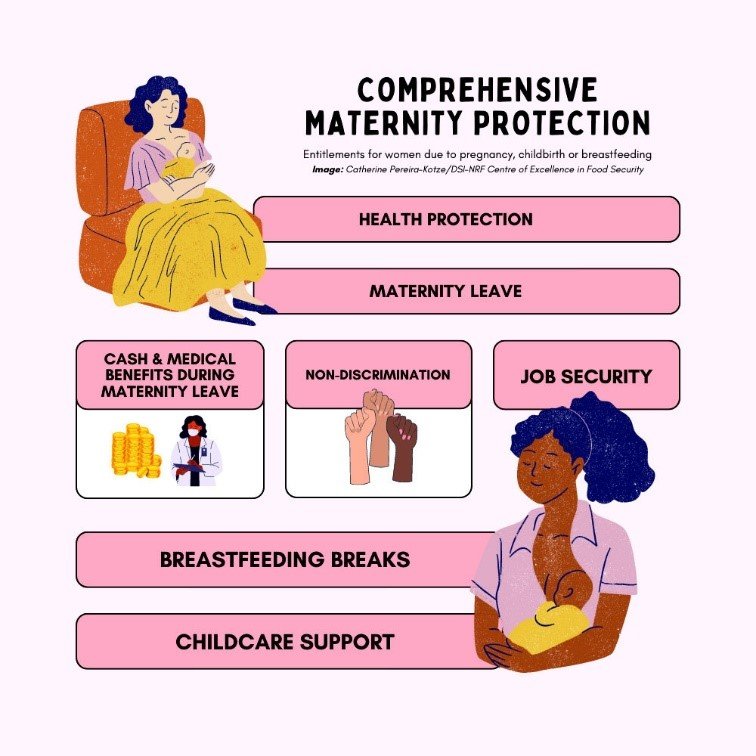Maternity Protection Policy in South Africa: A Fragmented State of Affairs
By Catherine Pereira-Kotze, RD (SA), PhD
Comprehensive maternity protection refers to a set of entitlements that should be available to all working women during pregnancy, around the time of childbirth and while breastfeeding. This is defined by the International Labour Organization (ILO) in the Maternity Protection Convention C183 of 2000 as including health protection at work, maternity leave, cash and medical benefits during maternity leave, non-discrimination, job security, breastfeeding or expressing breaks, and childcare support.
Source: Created by Catherine Pereira-Kotze and Carla Bernardo, DSI-NRF Centre of Excellence in Food Security for the following Opinion Editorial:
https://www.dailymaverick.co.za/article/2023-02-15-five-ways-to-improve-domestic-workers-maternity-protection/
Access to components of maternity protection such as paid maternity leave and breastfeeding support at work has direct benefits for children, mothers, employers, and businesses including longer breastfeeding duration, improved immunization rates, lower infant mortality, improved workplace productivity and decreased work absenteeism. There is substantial evidence to support the many short- and long-term health, economic and environmental benefits of breastfeeding for children, women and society. Workplace challenges remain a common reason why women stop breastfeeding earlier than recommended or planned. Therefore, ensuring that women can access maternity protection has become a recognised public health intervention. The theme for World Breastfeeding Week 2023 (held from 1-7 August annually) is “Enabling Breastfeeding: Making a difference for working parents” and this year’s campaign aims “to showcase the impact of paid leave, workplace support and emerging parenting norms on breastfeeding through the lens of parents themselves”.
As part of my PhD in Public Health research, completed through the University of the Western Cape, I (together with my supervisors and other colleagues) investigated the components of comprehensive maternity protection available and accessible to non-standard workers in the Western Cape, using domestic workers as a case study. The first phase of this research was a policy analysis of maternity protection available in South Africa, which we have described as fragmented, complicated, disorganised, dispersed, and lacking coherence.
From our document review and interviews with three key stakeholders, we were able to establish that South Africa most definitely has legislation and policies that incorporate the various components of comprehensive maternity protection – in fact, we identified 24 relevant documents. The challenge came in attempting to map out the components of maternity protection that could be found in specific documents, and then to determine the appropriate relevant government department responsible and how these provisions were implemented. The policy analysis and mapping that we conducted illustrated how the various components of maternity protection are dispersed across multiple government departments and numerous documents. This fragmented policy environment makes it difficult for employees and workers to know their rights and entitlements, but equally challenging for employers to understand their obligations.
Although most components of maternity protection are theoretically available in South African law, there were two important components that are currently not adequately guaranteed, namely access to cash payments while on maternity leave (which is quite complex to interpret through the current national social insurance programme) and paid breastfeeding breaks. Both are essential for creating an environment where women can combine breastfeeding and work. Furthermore, when we started to investigate existing research, it was already clear that even though most other components of maternity protection are available in policy and law, there is evidence that not all working women in South Africa are able to access these entitlements.
In subsequent research, we have also highlighted that access to maternity protection is even more fragile for vulnerable groups such as informal workers and those in non-standard employment (for example, domestic workers, who make up 12% of the female workforce in South Africa).
We have made many practical and policy recommendations for how access to maternity protection could be improved in South Africa. These include improved compliance with existing legislation, policy coherence, advocacy around labour entitlements and employer obligations, mandatory paid maternity leave for 6 months, legislated paid breastfeeding breaks, inclusion of informal workers into maternity protection policy and South Africa’s ratification of the ILO Maternity Protection Convention. It is important that maternity protection is viewed as an integral component of social protection, and a fundamental human right for all female workers. Improved maternity protection could contribute to decent work and minimum basic incomes and would have far-reaching health and development benefits, especially if women are supported to breastfeed.
Article Details
Legislation and Policies for the Right to Maternity Protection in South Africa: A Fragmented State of Affairs.
Catherine Pereira-Kotze, PhD , Kitty Malherbe, LLD, Mieke Faber, PhD, Tanya Doherty, PhD, and Diane Cooper, PhD.
First published July 8, 2022 Research Article
DOI: 10.1177/08903344221108090
Journal of Human Lactation
About the Author


